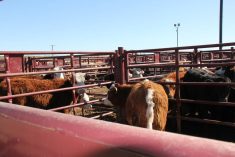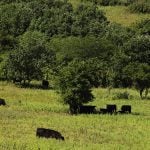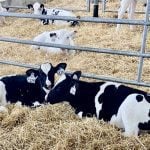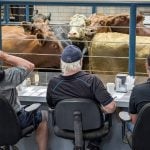In my previous column, our editor kept me on track when she titled it Show Us the Money. That was appropriate because I have noted that cattle producers do follow the money. That is to say, they absolutely do respond to market signals, but when no such signal exists, they can’t. In this column, I will again offer some not-so-novel thoughts about the future.
Canada’s cow-calf industry ranges from herds with less than 10 cows to ranching operations that run several thousand cows. For this discussion I have decided to create just three groups:
- The 53 per cent of herds that hold 12 per cent of the cows. Average herd size: 16.
- The 23 per cent of herds that hold 23 per cent of the cows. Average herd size: 56.
- The 24 per cent of herds that hold 65 per cent of the cows. Average herd size: 198.
The above is based on the 2016 Census, and there has certainly been a continuing reduction in beef, four per cent over the last five years. Herd numbers are likely to have declined a similar or greater amount. I am also aware that much of this decline has been forced because of a long and savage drought in the Prairies.
These three quite arbitrary divisions suggest that their needs, challenges and opportunities may be quite distinct.
- SHOW US THE MONEY, PART 1: What does the producer share of the retail beef dollar mean?
The first and largest group are those producers who once saw a modest-sized herd as a good fit as a secondary enterprise or with off-farm employment. One wonders, however, whether this “opportunity” has become more of a “nuisance” given the low profitability of this sector. I suggest it would be informative and useful to conduct an online survey to determine why they left or are considering leaving and, more importantly, what measures might slow or reverse the exodus.
Read Also
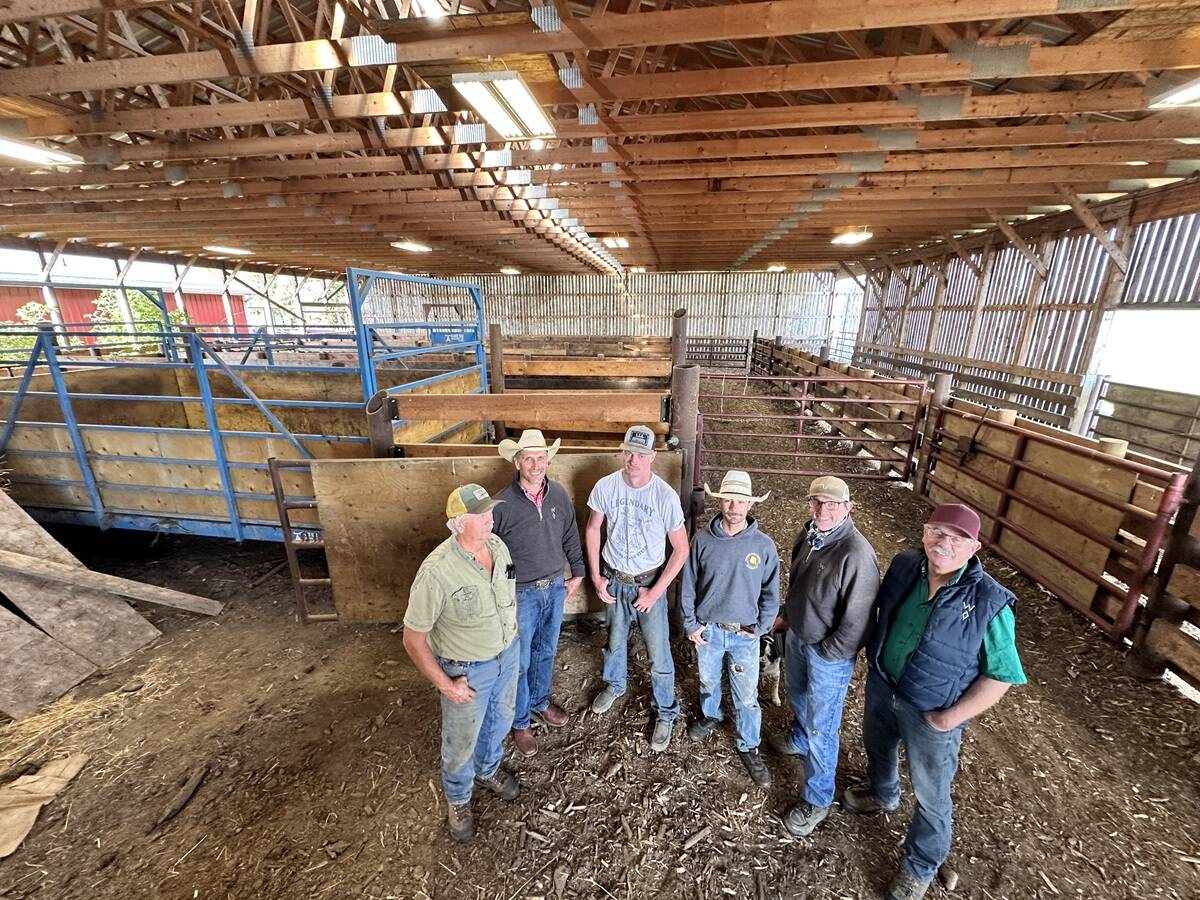
Farm families work together to graze cropland with cattle in the fall
These Alberta farm families have separate operations, but work together to manage their land
The second group of producers is critical to the industry’s future. That’s where we find a quarter of the national herd. The average herd size in this group is large enough to contribute significantly to the farm income and to benefit from innovations. I’ll come back to that anon.
The third group is the indispensable heart of the cow-calf industry. These ranchers are making the best possible use of land well-disposed for grazing and ill-disposed for much else. If we can’t harvest the meat protein from those spacious areas, they cannot contribute to the human diet.
So, what to do?
The industry’s common language
I’ll start, to no one’s surprise, with the grad- ing system. I have referred to it before as the “common language of the industry,” the point where shared interests, concerns and opportunities meet, the point where the product itself occupies centre stage. It is the portal between the live animal and the prod- uct. It is the basis for pricing. The grading system should and could be far more useful than it is presently.
In this discussion, I will focus only on the grades as they apply to fed, youthful cattle without referring to the grade standards for cow or bull carcasses. They are, however, an important part of the industry supplying about 15 per cent of the total tonnage.
The present grading system was introduced in 1993 and was intended to “assess” quality and “measure” yield. I used the word “assess” as it relates to quality because quality is a subjective characteristic that cannot be measured. Yield can and should be measured. What this means is that price negotiations should proceed based on quality and adjusted up or down for yield. I will illustrate with an example a little later.
Quality is the most important carcass attribute and is determined almost solely by the degree of marbling on the face of the longissimus dorsi muscle at the ribbing site. The quality grades are Prime, AAA, AA and A. A carcass that does not qualify for any of the aforementioned quality grades is assigned a B grade, of which there are four: B1, B2, B3 and B4.
In 2021 only one carcass in 1,000 was graded B1, so graded because it had less than two millimetres of fat cover at the ribbing site. Fewer than one carcass in 1,500 was graded B2 because of a fat colour deemed too yellow and implying grass-finished. About two carcasses per thousand were graded B3 because they were deemed of poor conformation or muscling. Finally, 1.3 per cent of carcasses were deemed dark cutters and consigned to the B4 grade. Dark cutters are a worrisome industry issue but not a grading issue. So fewer than half of one per cent of the carcasses, not counting the dark cutters, were downgraded for quality defects.
The above supports my assertion that the level of marbling is, in all but the rarest of cases, the sole determinant of quality. But the degree of marbling is an imperfect indicator of eating quality and tenderness. Some method of determining eating quality and tenderness must be found within, or supplementary to, the grading system because these traits are of paramount importance to consumers.
So, how important are these quality traits to the cow-calf producer and the cattle feeder?
The cow-calf producer is primarily and rightly concerned with high reproductive performance and a healthy calf that grows rapidly until sold at weaning or later for feeding. But since cow-calf producers rarely get feedback, they can’t be expected to be much concerned about the grade and yield of the final product. And those who are concerned don’t have the information to do much about it. But most cattle feeders will know where the best cattle, as determined by grade and yield, come from. This imbalance of information needs to be rectified.
The cattle feeder is concerned about quality because in many or most sales agreements, a premium is paid for Prime and AAA carcasses, and/or a discount for AA and A carcasses. To that end, as is now obvious, the feedlot operator often feeds the cattle to a considerable level of over-finish to ensure a Prime or AAA grade. The cattle feeder also desires feeder cattle that are healthy and growthy cattle based on a high degree of feed efficiency.
Who cares about yield?
It may be helpful to offer a little definition of terms. In doing so I do not wish to insult producers’ intelligence. Rather, I think it is useful and sometimes necessary to clarify and standardize some industry jargon.
“Dressing per cent” is the ratio of carcass weight to live weight. The average dressing per cent of a fed steer or heifer is 60 per cent.
“Yield per cent” is the ratio of carcass cut-out to carcass weight and the average yield is 75 per cent. Thus, the average saleable yield from 100 pounds of live animal is (100 x 60 per cent x 75 per cent = 45 per cent.)

There continues to be some confusion between dressing per cent and yield per cent, and no wonder, as I will explain directly.
When the decision was made to update and alter the beef carcass grading standards circa 1992, a very wise decision was made to include both quality and yield in the standards. To that end, Canadian meat scientists were consulted. They did some cut-out analyses and told us that the baseline or average “yield” of a fed beef carcass was 57.34 per cent with upward and downward adjustments based on measurements of the area of the longissimus dorsi muscle, and fat thickness measured at the ribbing site.
This was, at one and the same time, the most accurate and the most misleading yield indicator. It was the most accurate because it measured, very carefully, the amount of “closely trimmed lean meat in the five major primals.” Those five primals are the chuck, rib, short loin, sirloin and the round. Together these primals make up 84 per cent of the carcass. The researchers’ advice was that this was the best technique to measure yield variations between carcasses.
This was good science but bad from a common-sense perspective. We don’t reduce all of the carcasses to closely trimmed lean beef and we certainly don’t ignore the three remaining primals: the flank, plate and brisket. Consumers don’t buy closely trimmed lean beef in place of steaks and roasts. Most of all we shouldn’t be telling anyone that their cattle are yielding only about half of their carcass weight.
Until the most recent change in yield classes from three to five, the grading system was telling producers that:
- A Y1 carcass had a yield of 59 per cent or higher.
- A Y2 carcass had a yield varying from 54 per cent to 58 per cent.
- A Y3 carcass had a yield of 54 per cent or lower.
Such information was and is extremely misleading to producers, implanting the idea that the yield range in fed cattle runs from something as low or lower than 54 per cent to as high or higher than 59 per cent.
Other available and reliable sources, foremost among them Canfax, tell us that the average cut-out or “yield” of a fed cattle carcass is 75 per cent and varies up or down a few percentage points. Yield variations obviously indicate variations in value.
Common sense should have told us that we could easily have changed the base yield from 57.34 per cent to the new and correct base of 75 per cent and adjusted the yield percentages accordingly. The math is simple:
- A Y1 carcass would indicate a yield of 77 per cent or higher.
- A Y2 would indicate a yield ranging from 72 per cent to 76 per cent.
- A Y3 carcass would indicate a yield of 71 per cent or lower.
When the new five yield classes were introduced in 2019 to parallel the U.S. yield system, there was a missed opportunity to replace the yield classes with actual yield percentages based on carcass cut-out.
There is little need to comment on the new five-yield class system except to note that the yield percentages are lower to the point where the highest yield under the present system is lower than the lowest yield under the previous system.
While the above seems inexplicable, I am more troubled that the industry continues to express yield in categories when camera and computer technology exist to express the actual percentage yield. What is the point of developing technology capable of measuring yield to a percentage and not using it?
I write the above from the vantage point of 1996 when I was retained by the Canadian Cattlemen’s Association (as it was known at that time), to privatize the delivery of the grading service. I was told to proceed with all due speed because computer and camera-assisted technology would follow very closely behind the privatization of the service. I started my work in July 1995 and completed it nine months later and the industry moved seamlessly from government-employed graders to private delivery.
The price the industry is paying for virtually ignoring the yield issue is most evident in the chart above. The chart covers 1993 to 2021 and displays the per cent of carcasses that graded Prime or AAA and also were classified as Yield Class 1. It indicates that only about 10 per cent of carcasses met that condition in 1993. That is understandable since the previous system placed far too much emphasis on leanness. But over the next two decades, that percentage of high-quality, high-yield carcasses increased to nearly 25 per cent as the focus shifted to quality.
This chart is an excellent illustration of the biological tension that necessarily exists between quality and yield. The challenge for the industry is to find the right balance.
Since quality is more important, emphasis should be on how to achieve higher yields while maintaining as high a proportion of quality as desired. The chart shows us that the percentage of carcasses that were graded Prime or AAA was very low in 1993 because the earlier system had largely ignored quality. But as the new system favoured quality, the percentage of carcasses that were graded Prime or AAA and classified as Y1 increased steadily towards 25 per cent between 2003 and 2008. This was accomplished without any specific effort or intent, but it does demonstrate that such carcasses exist in significant proportion. Then we note that after 2008 the incidence of this desirable combination of quality and yield began to lose altitude and the percentage dropped precipitously to below five per cent in 2019 before creeping back up to six per cent in 2020 and 2021.
I suggest these conclusions from this data:
Since it was possible to have nearly one in four carcasses that have a combination of high quality and high yield without any apparent effort, imagine the possibilities if we try.
Producers at every level do not usually produce something they are not paid for. Hence little effort is made to produce high-yield carcasses, especially if it puts the quality grade at risk.
A high proportion of carcasses that are both of high quality and high yield is also the most efficient route that benefits producers and consumers alike.
A real-world example
So, a final word about how to accomplish this. I did this in my work with Natural Valley packers two decades ago.
A base price is negotiated on quality, for example, $290/cwt on the rail for an AAA carcass. A premium or discount would or could be applied.
Think carefully about what the seller and buyer have agreed upon. They have agreed that one pound of AAA carcass is worth $2.90 plus or minus premium, or discount.
The next step is frustratingly obvious. How many pounds are we talking about?
The camera-assisted technology tells us that a particular carcass has a 76 per cent yield. Recall that the base yield is 75 per cent. Therefore, the seller of the higher-yielding carcass gets ($2.90/75) x 76 = $2.93.
Until this is done,the producer of high-yield carcasses will be underpaid while the producer of lower-yield carcasses will be overpaid.
Here is where I recall my editor naming this two-part series Show Us the Money. There is absolutely nothing wrong with having a high percentage of AAA and better carcasses, nor is there anything wrong with striving for high yield. The reason for the present situation is that producers are rewarded for the higher-quality grades while yield is essentially ignored.
There are two ways of ensuring high-quality carcasses. It is obvious that the main route has been through the feed trough, and that route is increasingly costly. The better route is to breed and select cattle that will produce high yield and high quality in the same carcass. This can be done — but not without supplying the breeder and cow-calf producer with grading data and market signals that they can use.



